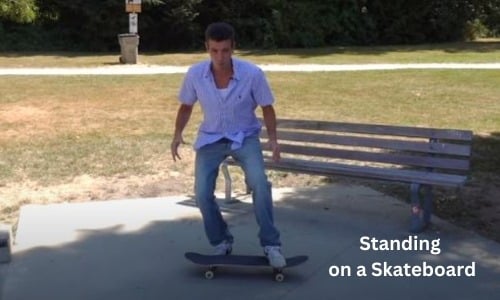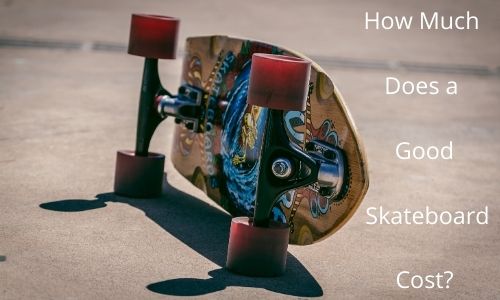How to Stand on a Skateboard? [A Quick Guide Really Can Help You]
( If you purchase through our sponsored links, we may receive a small commission at no extra cost to you )
Standing correctly on a skateboard is important to maintain balance, stability, and control while riding or attempting tricks.
To stand on a skateboard, place your front foot near the front bolts and your back foot near the tail, shoulder-width apart, and with toes slightly angled towards the sides of the board. Keep your knees slightly bent and your weight centered over the board. Practice maintaining balance on a stationary skateboard before attempting to ride or perform tricks.
Additionally, practicing balance and control on a skateboard can help improve overall body coordination and stability, which can translate to other physical activities as well.
Quick Guide on Standing on a Skateboard
- Don’t just jump on your feet
- Keep your leg bent
- Just step onto a skateboard, keep it straight
- Legs need to be shoulder-width apart
- Put one foot on the bolt but not so far so that It’s gonna tip the nose
- Again, keep your legs super bent so that you can have your hands on your knees
- Then put another foot on the board and stay low
- Still, keep your legs bent and stay low on the ground
- Keep both foot parallel, try this several times and you can stand right.
Get the Right Gear: Proper Equipment for Skateboarding
It can also be dangerous to stand correctly if you’re not properly equipped with the right gear. Wearing the proper gear is also crucial to reduce the risk of injuries, and to ensure that you’re able to maintain balance and control while standing and riding on a skateboard.
First and foremost, it’s important to wear a helmet while skateboarding. A helmet can help protect your head from injuries in the event of a fall or collision. Look for a helmet that fits properly and is certified by a recognized safety organization.
In addition to a helmet, wearing shoes with good grip is also important for skateboard standing. The grip on your shoes can affect your ability to control the board, especially when making sharp turns or attempting tricks. Look for shoes with flat soles and good grip to help keep your feet firmly planted on the skateboard.
Other protective gear such as knee pads and elbow pads can also be helpful, especially for beginners or those attempting to start skateboarding first. Look for gear that fits properly and provides adequate protection without hindering movement.
When choosing gear for skateboarding, it’s important to prioritize safety and quality over style or fashion. By investing in the proper gear and taking the time to find skate equipment that fits well and provides adequate protection, you’ll be able to start skateboarding with confidence and reduce the risk of injuries.
Find Your Stance: Right Foot Placement on a Skateboard
Before you can start riding a skateboard, it’s important to determine your stance. Your stance refers to the position of your feet on the board, and it can greatly affect your balance and control while riding.
There are 2 main stances in skateboarding: regular and goofy. Regular stance involves having your left foot at the front of the board, while goofy stance involves having your right foot at the front.
Here are some tips for determining which stance is right for you, and why it’s important to have a solid stance before attempting tricks.
Regular vs. Goofy Stance: Understanding the Difference
The main difference between regular and goofy stance is the position of your front foot on the board. In regular standing, your left foot is at the front of the skateboard, while in goofy style stance, your right foot would be at the front.
It’s important to note that your stance is not determined by your dominant hand or foot, but rather by which foot feels more comfortable at the front of the board. To determine your stance, try standing with your feet shoulder-width apart and have a friend give you a gentle push from behind.
Whichever foot you naturally put forward to catch yourself is likely your front foot.
Tips for Choosing the Right Stance
Determining your stance is ultimately a matter of personal preference, but there are some factors to consider when making your decision. Think about which foot feels more comfortable leading when you walk or run, or which foot you naturally use to kick a ball.
Experiment with both stances and see which feels more natural while standing on a skateboard. Remember that your stance can also affect the type of tricks you’re able to do, so it’s important to choose the stance that feels most comfortable for your goals.
Importance of a Solid Stance for Tricks
Having a solid stance is crucial for maintaining balance and control while riding a skateboard, but it’s especially important when attempting tricks. Tricks often involve shifting your weight or making quick movements, so having a stable and comfortable stance can help you execute tricks more effectively.
Before attempting any tricks, make sure you’ve spent enough time practicing your stance and foot placement. This will not only help you avoid injuries, but it will also give you a solid foundation to build upon as you progress in your skateboarding skills.
Place Your Feet Correctly
When it comes to skateboarding, one of the most crucial aspects of standing correctly on the board is placing your feet in the right position. This not only ensures a comfortable and stable ride but also helps you to maintain proper balance and control while riding or attempting tricks.
Here are some tips for placing your feet correctly on a skateboard:
- Start by standing with your feet shoulder-width apart on the board.
- Keep your toes pointed straight ahead and your heels slightly hanging off the edge of the board.
- Position your front foot with the ball of your foot over the front truck bolts, and your back foot with the ball of your foot over the back truck bolts.
- Make sure your weight is distributed evenly between both feet and keep your knees slightly bent.
- Experiment with your foot placement until you find a comfortable and stable position that works for you.
It’s important to keep your feet shoulder-width apart to ensure proper balance and stability while riding or attempting tricks. Incorrect foot placement can lead to a wobbly ride, loss of control, and even injury. By following these tips, you’ll be on your way to mastering the correct foot placement on a skateboard.
Practice Balancing
Once you have found the correct foot placement on a skateboard, the next step is to practice balancing. Balancing is essential to maintain stability and control while riding or attempting tricks on a skateboard.
Here are some tips for practicing balance on a stationary skateboard:
- Start by standing on the skateboard with both feet shoulder-width apart and knees slightly bent.
- Keep your eyes focused on a stationary object in front of you to help maintain your balance.
- Shift your weight slightly forward and backward, left and right, while keeping your feet planted in the same position on the board.
- As you become more comfortable with shifting your weight, try lifting one foot off the board and balancing on the other foot.
- Once you’ve mastered balancing on a stationary skateboard, try practicing balance while moving at a slow speed.
To maintain balance while moving on a skateboard, you need to shift your weight in the direction you want to go. For example, to turn right, shift your weight to your toes on your left foot, and to turn left, shift your weight to your toes on your right foot. Always keep your knees slightly bent to maintain stability and control.
By practicing balancing on a stationary skateboard and mastering weight shifting while moving, you’ll be well on your way to standing correctly on a skateboard and enjoying a safe and enjoyable ride.
Push Off
After you have found your stance, placed your feet correctly, and practiced balancing on a stationary skateboard, the next step is to learn the proper technique for pushing off.
Here are some tips for mastering the push-off technique:
- Place your back foot on the tail of the skateboard and your other foot near the middle of the skateboard, with your toes pointed slightly outward.
- Push off with your back foot to gain momentum, keeping your front foot planted firmly on the board.
- As you begin to roll forward, adjust your stance by shifting your front foot to a comfortable position over the front trucks of the skateboard.
- Keep your knees slightly bent and your weight centered over the board for balance and control.
- Practice pushing off with your back foot while maintaining your balance and control over the board.
Remember, mastering the push-off technique takes practice and patience. Take it slow, focus on proper form, and keep practicing until you feel comfortable and confident on the board.
By mastering the push-off technique, you’ll be able to enjoy a smooth and controlled ride on your skateboard, with the ability to adjust your stance and maintain balance as needed.
Conclusion
Standing on a skateboard for the first time can be challenging, but with the right approach and precautions, it can be a fun and rewarding experience. It’s important to start with the basics, including finding the right gear, determining your stance, placing your feet correctly, and practicing balancing.
Remember to take it slow and be patient with yourself as you develop these fundamental skills. By staying focused, taking your time, and prioritizing safety, you can increase your confidence and make progress toward mastering this exciting activity.


![9 Best Skateboard Pants In 2023 [Good Fit, Durable & Comfortable]](https://sportstotry.com/wp-content/uploads/2020/06/Best-Skateboard-Pants.jpg)




![How To Paint A Skateboard? [ With Acrylic and Spray Paints]](https://sportstotry.com/wp-content/uploads/2022/04/How-to-Paint-A-Skateboard.jpg)